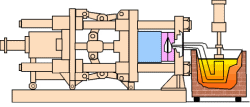Zinc Electrical Parts. A great number of small and medium sized metal parts comprising most electrical and electronic equipment are made of zinc. These zinc die casting parts are popular choices in the production of various electrical and electronic equipment. Zinc parts boast of strength and hardness not always present in parts that are plastic molded, sand casted, permanent mold casted, forged, stamped, and screw machined. Zinc material advantages especially in the electrical industry are resistant to temperature extremes and have superior electrical properties.
These zinc die casting parts are efficient both in terms of cost and functionality. Cost efficiency is one of the zinc material advantages because zinc parts can be manufactured in one single piece of multiple components. This eliminates the need for later assembly or for additional fastening implements. Furthermore, this results in more durable parts that rely more on the strength of its material rather than in the strength of the fastening material used or the way the parts are joined together. The durability of the zinc die casting parts spell their efficiency in terms of their use and function.
Zinc die casting parts also have excellent shielding properties that allows it to function in internal circuits as an electrical ground. These metal parts have high thermal conductivity that makes them fitting choices for electronic connectors as well as small components in consumer electrical and electronics equipment. The added benefit of the zinc die casting parts’ finishing versatility also allows for wear resistance in when used as external parts of various implements. These zinc material advantages make zinc die casting company parts an efficient choice in most electronic and electrical applications.


